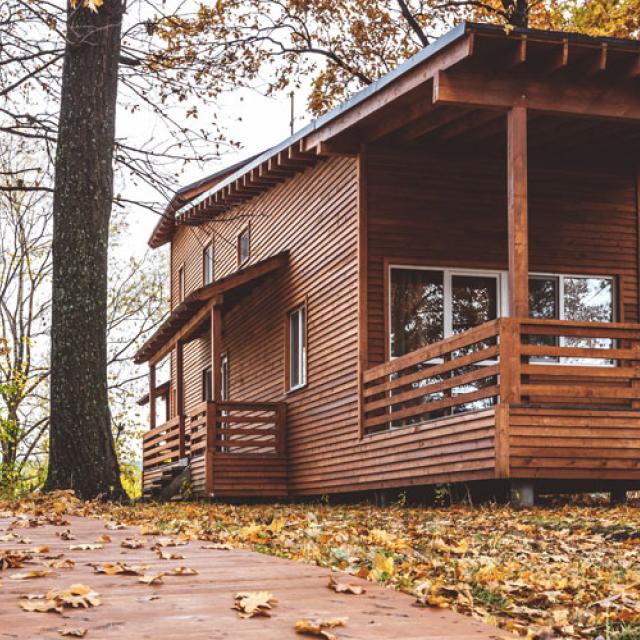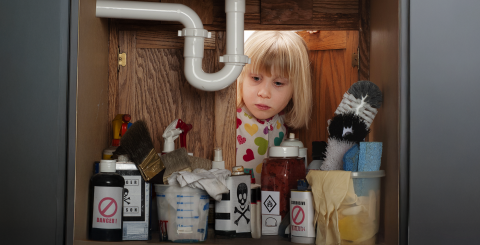Getting the cottage ready for winter: Follow our guide!

It’s your haven of peace. The place you escape to on weekends or for the whole summer to get away from the hustle and bustle of modern life. You may also spend Christmas there with your family in a quiet, relaxing atmosphere. As fall draws to a close, it’s essential that you get your cherished cottage ready for winter, just as you do your main residence.
Having home insurance for your second residence is of course a must, but prevention is still the best way to avoid unpleasant surprises. How do you go about it? We’ve put together a practical guide to make sure your cottage is as ready as it can be to face the hazards and harsh weather of winter. Follow our step-by-step guide and save yourself a lot of hassle!
GETTING THE COTTAGE READY FOR WINTER IN 5 STEPS
The temperature goes up and down in winter—snow melts, rain freezes, and wind is often part of the mix. Your cottage requires seasonal maintenance and safeguards to withstand winter and minimize the possibility of property damage, water infiltration, and fire.
Since you’re probably not there very often during the week, it is all the more important to reduce the risk of incidents that could ruin a long-awaited weekend in your oasis. Yes, in the worst case scenario you have cottage insurance, but it’s better to be prepared than to have to call your insurance company when you were planning to relax at the cottage.
Step 1: Water, the greatest threat
We can’t say it often enough: water damage is the leading cause of home insurance claims. So you want to do everything you can to prevent water infiltration , which often leads to costly repairs. To do this, consider the following. Since water can get into—and damage—your cottage many different ways in winter, different actions are required.
Drain the roof
Check the roof drains carefully to make sure they’re clear of debris. If necessary, install a gutter (and maybe a gutter guard, if required) and make sure it’s not blocked. This is critical, as water infiltration through the roof is a real pain.
An efficient roof drainage system adapted to your cottage’s roof type (flat or sloped) will efficiently redirect and evacuate water. The Régie du bâtiment du Québec website has some very useful information on this subject. During the winter, you should also check if the roof needs to be cleared of snow.
Make sure surface water runs off
Note that a 10% slope is required around the full perimeter of your cottage foundation to direct surface water at least 6 feet (1.8 m) away from the foundation using a horizontal section. To get your cottage ready for winter, check to make sure the slope is correct.
Fix cracks
It’s especially important to make sure the ground around the foundation is well drained to guarantee a good watertight seal before cracks are sealed. We recommend you bring in the professionals. They’ll know what to do to ensure cracks are repaired properly.
Maintain outside entrances
Drains must be well maintained, i.e., cleared and cleaned, at all times. This will ensure that water can be drained efficiently during heavy rain or snow melt. You don’t want to arrive at your cottage on a Friday night in winter to find that water has leaked in while you were away because you didn’t take steps to keep outside water at bay.
Clean the window wells and check the windows
If you have window wells, make sure they’re clean and well drained at all times. Also remember to check the window sealant. It must be in good condition to limit the risk of water infiltration, which could cause damage.
Stay on the lookout!
Water is definitely full of surprises and can be the source of many problems. The watchword for your cottage in winter? Vigilance. Be on the lookout for worrying signs such as mould, strange odours, and high humidity levels—just as you do for your main residence. That way, you can react quickly and take the necessary corrective measures.
Step 2: Fire and the fireplace
Ah, those cozy fires at the cottage! They’re synonymous with peace and contentment, but they’re also a source of danger if the chimney in your second home is not properly maintained.
Have a flame-resistant cottage to protect you from forest fires? Good for you! But like water, fire damage can come from many sources. These losses may be covered by cottage insurance, but again, if only for your own safety, it’s in your best interest to prevent them.
If you have a fireplace or wood stove in your cottage, whether it’s your main heating system or a backup, it’s essential to have the chimney cleaned at least once a year. This will prevent fires, smoke damage, and the danger of carbon monoxide.
Fall is also a good time to make major repairs before winter. Be sure to safely clean and repair the chimney or, better yet, call in a professional.
Step 3: Be careful with the heating!
Speaking of heating, did you know that it’s best to keep the heat on in the winter when you’re away? You obviously turn it down when you’re not there to reduce costs, but don’t turn it off completely. By maintaining a minimum level of heat in the cottage, you’ll not only protect the pipes from freezing, you’ll also prevent the deterioration that moisture can cause. According to Corporation des maîtres électriciens du Québec, keeping the temperature around 10°C is sufficient.
If you close up your cottage for the winter, even if you maintain a minimum temperature, the plumbing can freeze and trigger a claim if there’s a power failure. It’s always safer to turn off the water supply, drain all plumbing, and pour plumbing antifreeze into toilet bowls and all sink, shower, and bathtub drains.
Step 4: It’s time to put things away
You also need to go through the seasonal chore of putting things away to protect your belongings. Wash and store garden furniture. If you have a boat, canoe, or pedal boat, it’s time to take it out of the water. Bikes, lawnmowers, hoses, garden tools, barbecues, and other items should be put away. In short, you need to make sure your belongings stay in good condition so you can enjoy them again when winter is over.
Step 5: Do you have sufficient cottage insurance?
You should get the right insurance for your needs. Getting your cottage or second home ready for winter includes this step to give you peace of mind. Contact a damage insurance representative to get the right coverage for your needs and circumstances. There’s a variety of insurance policies and coverage options available for cottages.
Insurance on your second home may include the same type of coverage as your main residence (comprehensive or named risk, civil liability, etc.). However, certain conditions may apply. Sometimes insurers will insure a cottage only if they also insure the main residence. The key is to do your homework and compare offers.
Feel free to contact us to get a quote for your cottage insurance and other insurance needs. Promutuel Insurance is a proud local mutual that has been insuring Quebecers in every region of the province for nearly 170 years.
On that note, we hope you find our guide useful. Have a nice winter at the cottage!




